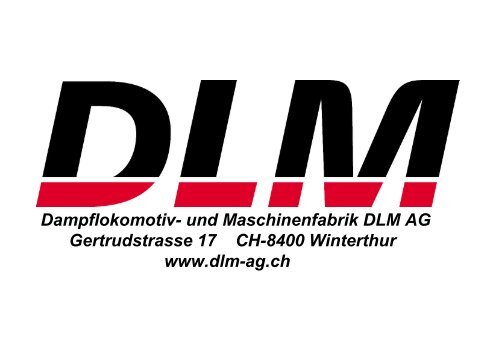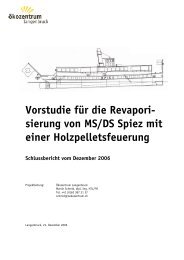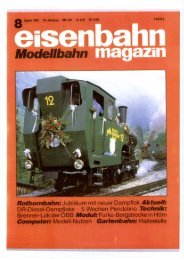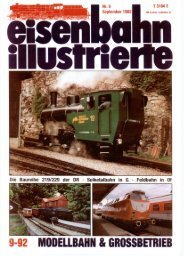Modern Steam english.pdf - DLM AG
Modern Steam english.pdf - DLM AG
Modern Steam english.pdf - DLM AG
Create successful ePaper yourself
Turn your PDF publications into a flip-book with our unique Google optimized e-Paper software.
Dampflokomotiv- und Maschinenfabrik <strong>DLM</strong> <strong>AG</strong><br />
Gertrudstrasse 17 CH-8400 Winterthur<br />
www.dlm-ag.ch
MODERN STEAM<br />
AN ECONOMIC AND ENVIRONMENTAL ALTERNATIVE TO DIESEL TRACTION
modern steam eliminates the well known<br />
deficiencies of traditional steam traction<br />
ADVANT<strong>AG</strong>ES OF MODERN STEAM LOCOMOTIVES<br />
• One man operation, no fireman<br />
• Push-pull trains with remote control possible<br />
• Excellent combustion with oil firing or fireless<br />
• Higher thermal efficiency<br />
• Full insulation of boiler and cylinders<br />
• Quick start-up<br />
• Limited servicing requirements<br />
• High mechanical efficiency<br />
• No spilling of lubrication oil<br />
• Interchangeable parts
Drawing of the all-new Rack <strong>Steam</strong> Locomotive<br />
based on modern steam Technology
Schematic of the all-new Rack <strong>Steam</strong> Locomotive<br />
based on modern steam Technology
One-man operated new <strong>Steam</strong> Locomotive in<br />
action on the Swiss Brienz-Rothorn Railway
ADVANT<strong>AG</strong>ES OF LIGHT OIL FIRING<br />
• One-man operation possible<br />
• No fire cleaning, no ashes, no cinder<br />
• Cleanest combustion, no smoke<br />
• Better efficiency, no unburnt fuel loss<br />
• No sparks, no line-side fires<br />
• Easy adjustable<br />
• Consistent fuel quality<br />
• Requires less skill to operate
Comparison of Diesel Locomotive No. 11, built 1987<br />
with <strong>Steam</strong> Locomotive No. 12, built 1992
EXHAUST GAS ANALYSES<br />
Comparison between <strong>Steam</strong> and Diesel Locomotive<br />
18<br />
17.35<br />
16<br />
[g/kW u h]<br />
14<br />
12<br />
10<br />
8<br />
6<br />
0.99<br />
4<br />
2<br />
0<br />
0.21<br />
1.84<br />
0.21<br />
Diesel locomotive Hm 2/2<br />
w ith engine built 1992<br />
CO<br />
NO x<br />
SO 2 *<br />
0.45<br />
<strong>Steam</strong> locomotive H 2/3<br />
built 1992, * w ith reduced sulphur
Brienz-Rothorn Railway<br />
The only Railway in the World with three Generations<br />
of <strong>Steam</strong> Locomotives (1891, 1933, 1992) in Service
Schafberg Railway in Austria
Comparison of Direct Operating Costs<br />
of the Locomotives of the Schafberg Railway (2000 to 2002)<br />
700<br />
600<br />
500<br />
in %of <strong>Steam</strong>, new<br />
400<br />
300<br />
200<br />
100<br />
0<br />
<strong>Steam</strong>, old Diesel (Railcar) <strong>Steam</strong>, new
52 8055<br />
- rebuilt 1998/99<br />
- 60% new<br />
- light oil-firing<br />
- roller bearings<br />
<strong>Modern</strong>izing 52 8055<br />
52 1649 ►52 8055<br />
- built in 1943<br />
- rebuilt in 1960<br />
- coal fired<br />
- plain bearings
Roller Bearings on all Axles and Rods
Coal-fired 52 7596 + light oil-fired 52 8055
<strong>Modern</strong>ized 52 8055 pulls the famous Orient-<br />
Express train over the Bridge at Eglisau
Fireless Locomotives<br />
economic – clean – silent – environmentally friendly – CO 2 -neutral
Shunting-Diesel Locomotives<br />
Exhaust – CO 2 – Noise – Idling – Maintenance – Oil-dependence
Shortcomings of Diesel Traction<br />
• No direct drive from engine to wheels<br />
– diesel-electric, -hydraulic or -hydrostatic<br />
► Complex Drive ► High Maintenace Costs<br />
► 75% Idling ► Waste of Energy, Noise<br />
• Very bad Emission Values<br />
► Particle filters and Catalyst necessary<br />
► Fitting of APUs (Auxiliary Power Unit)<br />
► addsto Complexity, Capital- + Maintenace Costs<br />
• High Noise Level in Operation and Idling<br />
• Dependence on Oil
Idling of Diesel Locomotives<br />
Idling Consumption: Diesel Fuel:<br />
3.5 - 5 gals/hour<br />
Lubrication Oil: 0.4 - 0.5 gals/hour<br />
= ► Idling Consumption: Diesel Fuel: 13 – 19 Litre/hour<br />
Lubrication Oil: 1.5 – 2 Litre/hour
Efficient Diesel Traction?<br />
Discharging Aluminium Oxide, Martinswerk Germany<br />
- Discharging time for the entire train: approx. 4 hours<br />
- Running time of Diesel engine: 4 hours =► Idling: approx. 95 %<br />
- Consumption of Diesel fuel: 64 l equal to 640 kWh<br />
- Consumption of lubricating oil: 7 l<br />
- Actual work done: approx. 10 kWh =► Efficiency: approx. 1.6 %
Schematic of a Diesel Locomotive
Schematic of a Fireless Locomotive
Advantages of Fireless Technology<br />
• Emission-free, quiet operation, soundless stand-by<br />
• External energy production:<br />
– Any fuel possible (local, cheap, CO 2 -neutral)<br />
– Solar-thermal steam production<br />
– Waste heat, e.g. from combustion engines<br />
• Explosion-proof, no sparks, no fuel<br />
• No oxygen needed: Ideal for work or rescue in tunnels<br />
• Quick re-charging (5 - 20 minutes rather than several hours)<br />
• Maximum starting torque (tractive effort)<br />
• Overloadable<br />
• One man operation, Radio remote control possible<br />
• Simple, robust, reliable, low on maintenance<br />
• Longevity (Batteries: 5-10 years, pressure vessels: 60-100 years)<br />
• No energy consumption for idling/stand-by
Energy Density of Fuels<br />
Brennstoff Schütt-Volumen für 10'000 kWh<br />
2.5<br />
1.5<br />
Brennstoff- Gewicht für 10'000 kWh<br />
Holzschnitzel* 2940 kg<br />
Kantenlänge [Meter]<br />
2<br />
1.5<br />
1<br />
0.5<br />
Braunkohle 3.4 m 3 0<br />
Holzschnitzel 11.8 m 3<br />
Holzpellets 3.07 m 3<br />
Holzpellets 3.1 m 3<br />
Steinkohle 1.6 m 3<br />
Heizöl EL 1.03 m<br />
Diesel / Heizöl EL<br />
3<br />
1.03 m 3<br />
Wasserverdängung Kantenlänge<br />
[Meter]<br />
1<br />
0.5<br />
Holzpellets 2000 kg<br />
Braunkohle 1880 kg<br />
Steinkohle 1230 kg<br />
Diesel / Heizöl EL 870 kg<br />
0<br />
0 0.5 1 1.5 2 2.5<br />
Kantenlänge [Meter]<br />
0 0.5 1 1.5<br />
Wasserverdrängung Kantenlänge [Meter]<br />
The high energy density explains the dominance of oil in transport:<br />
99% of the fuel used for traffic is based on oil!
Mobility with Stationary Energy<br />
• The density of energy plays a major<br />
role on all means of transport, where<br />
weight and volume are always limited<br />
=► only a few types of fuel are suitable<br />
in transport and therefore expensive<br />
• The energy density is not important<br />
on stationary power plants<br />
=► all sorts of fuels are suitable and thus<br />
a lot cheaper
Comparison of Swiss Energy Prizes<br />
for the same calorific Value<br />
20<br />
18<br />
16<br />
14<br />
12<br />
10<br />
8<br />
6<br />
4<br />
2<br />
0<br />
Energiepreise [Rp./kWh]<br />
Diesel (18.10.2004)<br />
Benzin (18.10.2004)<br />
Biogas Treibstoff (3.2004)<br />
Erdgas Treibstoff (3.2004)<br />
Erdgas zum Heizen (Winter 2003/2004)<br />
Fernwärme IWB (Winter 2003/2004)<br />
elektrischer Strom (Grosskunden EWZ, 2004)<br />
mittelgrosse Solaranlage WW 70m3<br />
Klein-Solaranlagen WW (z.B. 6m2)<br />
Holz-Pellets (CH, Stand 8.2004), Grossbezüger<br />
Stückholz 0.5/0.33m feucht gemischt<br />
Stückholz 0.5/0.33m trocken gemischt<br />
Heizöl EL (CH, Stand 18.10.2004, 6000 Liter ab Basel)<br />
Ratio between cheapest and most expensive fuel: 1:4
„Filling Station“ for steam<br />
at the Swiss „Falken“<br />
Brewery in Schaffhausen<br />
Sulzer three-pass boiler<br />
delivers saturated steam
Filling station in the locomotive shed<br />
Grosskraftwerk Mannheim, Germany
Active Fireless Locomotives<br />
• Grosskraftwerk Mannheim D 3 Locos<br />
• Sodawerke Stassfurt D 3 Locos<br />
• Sasol Werk Herne D 1 Loco<br />
• Ramonta <strong>AG</strong> Amsdorf D 1 Loco<br />
• Schoeller GmbH Osnabrück D 1 Loco<br />
• Papierfabrik Theresienthal A 1 Loco<br />
• <strong>DLM</strong> <strong>AG</strong> Winterthur CH 2 Locos<br />
• Setuza-Werk Usti nad Labem CZ 2 Locos<br />
• Kraftwerk Ljubljana<br />
Slov. 1 Loco<br />
• Semboro Sugar Mill<br />
Java 2 Locos
Setuza-Werk Usti nad Labem
Grosskraftwerk Mannheim
High-pressure (85 bar) fireless locomotive<br />
working on superheated steam (Gilli cycle)
Fireless Locomotive FLC 0147 derelict at Heinsberg,<br />
Germany (May 18, 2009) , later re-commissioned by <strong>DLM</strong>
Presentation of the fireless locomotives FLC 03147 and<br />
FLC 03160 at Schaffhausen on 26. and 27.10.2010
FLC 03160 of <strong>DLM</strong>
Other Uses for Thermal Storage<br />
Present Use<br />
• <strong>Steam</strong>-powered Catapults on Air Carriers<br />
• Thermal Storage in Industry<br />
• Thermal Storage for solar-thermal Power Plants<br />
Future and Potential<br />
• Industrial Trucks, Thermomobil (being developed)<br />
• Branch line trains (e.g. Hauenstein, Switzerland)<br />
• Tunnellocomotives, Tunnelrescue Vehicles<br />
• Buses, Taxis<br />
• Vaporetti (Venice), Watertaxis<br />
• Ferries (e.g. Meilen – Horgen)
<strong>Steam</strong>-powered Catapult<br />
accelerates a 36 t airplane within only 92 m from a standstill to 260<br />
km/h in 3 Seconds. Without the catapult 1.5 km are necessary.<br />
A Ferrari (1.25 t) needs 9.5 Seconds from 0 to 200 km/h.<br />
Ultrahigh Reliability is Essential<br />
to Ensure Safety for the Pilots and Plains.
1st „Proof of Concept“ fireless road vehicle
2nd „Proof of Concept“ fireless road vehicle
Thermomobil HOT2GO
„Cost Saving“ on underused Branch Lines
More revenue is a much better solution!
Project: modern steam on the<br />
Swiss Hauenstein line<br />
• Problem: In spite of a highly rationalised operation,<br />
electric trains achieve a cost recovery of 19% only<br />
• Analyses: Insufficient revenue due to insufficient<br />
patronage in this sparsely populated region<br />
• Idea: Increase revenue and patronage substantially<br />
with additional full paying passengers (tourists)<br />
• Solution: Introduce modern clean and efficient steam<br />
trains instead of railcars
modern steam<br />
attractive, but not old-fashioned
<strong>Steam</strong> Locomotives attract (full paying)<br />
Tourists who ride the trains in off-peak times<br />
resulting in much higher revenue<br />
Die Dampfbahn füllt das Ertragsloch
modern steam on the Hauenstein
Successfull Tests on the Hauenstein<br />
2008: 16 Trains during the 150 year celebrations<br />
2009: 78 Trains during the 17- day patronage tests<br />
2010: 36 Trains during the 8- day economic tests<br />
All steam trains were 100% reliable and on time Q.E.D.<br />
Increase of patronage and income by factors Q.E.D.
Design proposal for an all-new modern steam<br />
4-8-4 tank locomotive, oil-fired or fireless<br />
This modern locomotive can also be used on push-pull trains<br />
and is intended for regular operation on the Hauenstein line<br />
Please see: www. modern-steam-hauenstein.ch
Dampflokomotiv- und Maschinenfabrik <strong>DLM</strong> <strong>AG</strong><br />
Gertrudstrasse 17 CH-8400 Winterthur<br />
www.dlm-ag.ch






